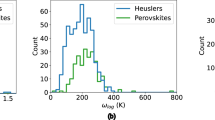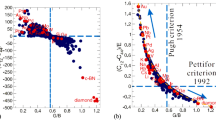Abstract
Stoichiometric intermetallic compounds have always been touted for their attractive chemical, physical, electrical, magnetic and mechanical properties, but few practical uses have materialized because they are brittle at room temperature1,2,3,4. Here we report on a large family of fully ordered, stoichiometric binary rare-earth intermetallic compounds with high ductility at room temperature. Although conventional wisdom calls for special conditions, such as non-stoichiometry, metastable disorder or doping to achieve some ductility in intermetallic compounds at room temperature, none of these is required in these unique B2 rare-earth compounds. Ab initio calculations of YAg, YCu and NiAl crystal defect energies support the observed deformation modes of these intermetallics.
This is a preview of subscription content, access via your institution
Access options
Subscribe to this journal
Receive 12 print issues and online access
$259.00 per year
only $21.58 per issue
Buy this article
- Purchase on Springer Link
- Instant access to full article PDF
Prices may be subject to local taxes which are calculated during checkout




Similar content being viewed by others
References
Cahn, R.W. Intermetallics: new physics. Contemp. Phys. 42, 365–375 ( 2001).
Chen, G.L. & Liu, C.T. Moisture induced environmental embrittlement of intermetallics. Int. Mater. Rev. 46, 253–270 ( 2001).
Fleischer, R.L. & Zabala, R.J. Mechanical properties of diverse binary high-temperature intermetallic compounds. Met. Trans. A 21, 2709–2715 ( 1990).
Sauthoff, G. in Intermetallic Compounds: Vol. 1, Principles (eds Westbrook, J.H. & Fleischer, R.L.) 911–934 (Wiley, New York, 1994).
Hahn, K.H. & Vedula, K. Room temperature tensile ductility in polycrystalline B2 NiAl. Scripta Metall. 23, 7–12 ( 1989).
Liu, C.T., George, E.P., Maziaz, J.H. & Schneibel, J.H. Recent advances in B2 iron aluminide alloys: deformation, fracture, and alloy design. Mater. Sci. Eng. A 258, 84–98 ( 1998).
Takasugi, T., Masahashi, N. & Izumi, O. Electronic and structural studies of grain-boundary strength and fracture in L12 ordered alloys-III. On the effect of stoichiometry. Acta Metall. 35, 381–391 ( 1987).
Reed-Hill, R.E. & Abbaschian, R. Physical Metallurgy Principles 3rd edn 357 (PWS Kent, Boston, 1992).
Liu, C.T., White, C.L. & Horton, J.A. Effect of boron on grain-boundaries in Ni3Al. Acta Metall. 33, 213–229 ( 1985).
Sutou, Y., Omori, T., Kainuma, R., Ono, N. & Ishida, K. Enhancement of superelasticity in Cu-Al-Mn-Ni shape-memory alloys by texture control. Metall. Mater. Trans. A 33, 2817–2824 ( 2002).
Rossi, A. & Iandelli, A. The crystalline structure of PrMg. Atti Accad. Naz. Lin. 18, 156–158 ( 1933).
Salishchev, G.A. et al. Formation of a submicrocrystalline structure in TiAl and Ti3Al by hot working. Mater. Sci. Eng. A 286, 236–243 ( 2000).
Ritter, C., Ibarra, M.R., & Ibberson, R.M. The low-temperature orthorhombic structure of YCu. J. Phys. Condens. Matter 4, L39–L42 ( 1992).
Ibarra, M.R., Chien, T.S. & Pavlovic, A.S. Structural instability in RCu intermetallic compounds. J. Less Common Metals 153, 233–243 ( 1989).
Ibarra, M.R., Marquina, C., Pavlovic, A.S. & Ritter, C. Study of the influence of the magnetoelastic energy in driving the magnetic and structural transition in TbCu. J. Appl. Phys. 70, 5989–5991 ( 1991).
Kim, T., Hong, K.T. & Lee, K.S. The relationship between the fracture toughness and grain boundary character distribution in polycrystalline NiAl. Intermetall. 11, 33–39 ( 2003).
Vedula, K., Hahn, K.H. & Boulogne, B. in High-Temperature Ordered Intermetallic Alloys III MRS Proc. Vol. 133 (eds Liu, C.T., Taub, A.I., Stolloff, N.S. & C.C. Koch) 299–304 ( 1989).
Causey, A.R. & Teghtsoonian, E. Tensile deformation of polycrystalline beta-prime AuZn. Metall. Trans. 1, 1177–1183 ( 1970).
Jena, A.K., Westbrook, J.H. & Bever, M.B. Recovery of the cold-worked compound AgMg. ASM Trans. Q 62, 784–793 ( 1969).
Yamagata, T. Correlation between characters of dislocations and operative slip systems in CsCl-type intermetallic compounds. J. Phys. Soc. Jpn 45, 1575–1582 ( 1978).
Yoo, M.H., Takasugi, T., Hanada, S. & Izumi, O. Slip modes in B2-type intermetallic alloys. Mater. Trans. JIM 31, 435–442 ( 1990).
Blaha, P., Schwarz, K. & Luitz, J. WIEN97, A Full Potential Linearized Augmented Plane Wave Package For Calculating Crystal Properties (Karlheinz Schwarz, Technic, Univ. Wien, Austria 1999).
Hong, T. & Freeman, A.J. Effect of antiphase boundaries on the electronic structure and bonding character of intermetallic systems: NiAl. Phys. Rev. B 43, 6446–6458 ( 1991).
Fu, C.L. & Yoo, M.H. Deformation behaviour of B2 type aluminides: FeAl and NiAl. Acta Metall. Mater. 40, 703–711 ( 1992).
Rice, J.R. Dislocation nucleation from a crack tip: an analysis based on the Peierls concept. J. Mech. Phys. Solids 40, 239–271 ( 1992).
Rice, J.R. & Beltz, G.E. The activation energy for dislocation nucleation at a crack. J. Mech. Phys. Solids 42, 333–360 ( 1994).
Acknowledgements
The authors thank V. K. Pecharsky, S. B. Biner and B. N. Harmon for their comments and valuable suggestions. We gratefully acknowledge the support of the Iowa State University, Institute for Physical Research and Technology and the Ames Laboratory of the US Department of Energy, Office of Basic Energy Sciences, Division of Materials Sciences, under Contract No. W-7405-ENG-82.
Author information
Authors and Affiliations
Corresponding author
Ethics declarations
Competing interests
The authors declare no competing financial interests.
Supplementary information
Rights and permissions
About this article
Cite this article
Gschneidner, K., Russell, A., Pecharsky, A. et al. A family of ductile intermetallic compounds. Nature Mater 2, 587–591 (2003). https://doi.org/10.1038/nmat958
Received:
Accepted:
Published:
Issue Date:
DOI: https://doi.org/10.1038/nmat958
This article is cited by
-
In-situ directed energy deposition of Al based low density steel for automotive applications
Scientific Reports (2023)
-
Evidence of twinning-induced plasticity (TWIP) and ultrahigh hardness in additively-manufactured near-eutectic Ni–Nb
Journal of Materials Science (2023)
-
Ultra-dense dislocations stabilized in high entropy oxide ceramics
Nature Communications (2022)
-
A highly distorted ultraelastic chemically complex Elinvar alloy
Nature (2022)
-
High-entropy intermetallics: from alloy design to structural and functional properties
Rare Metals (2022)



